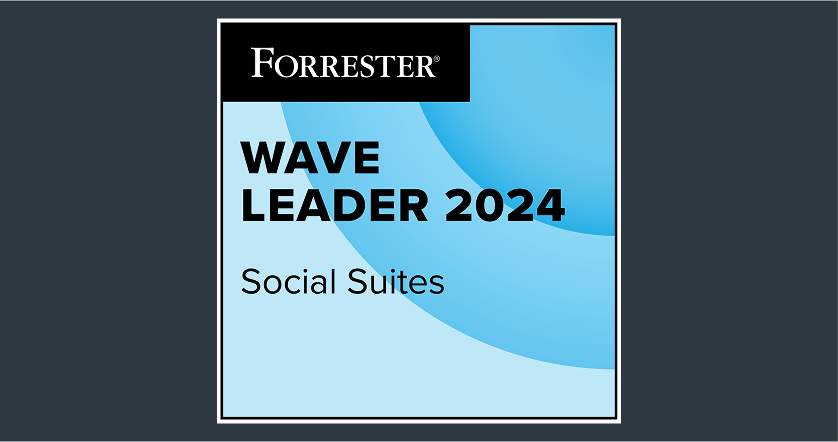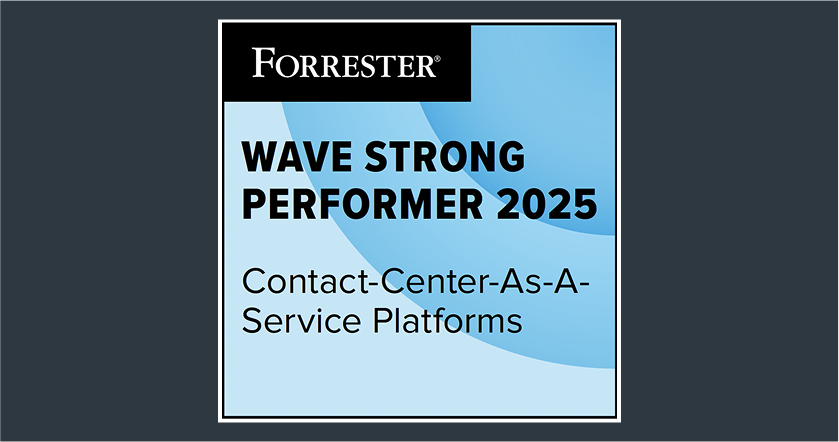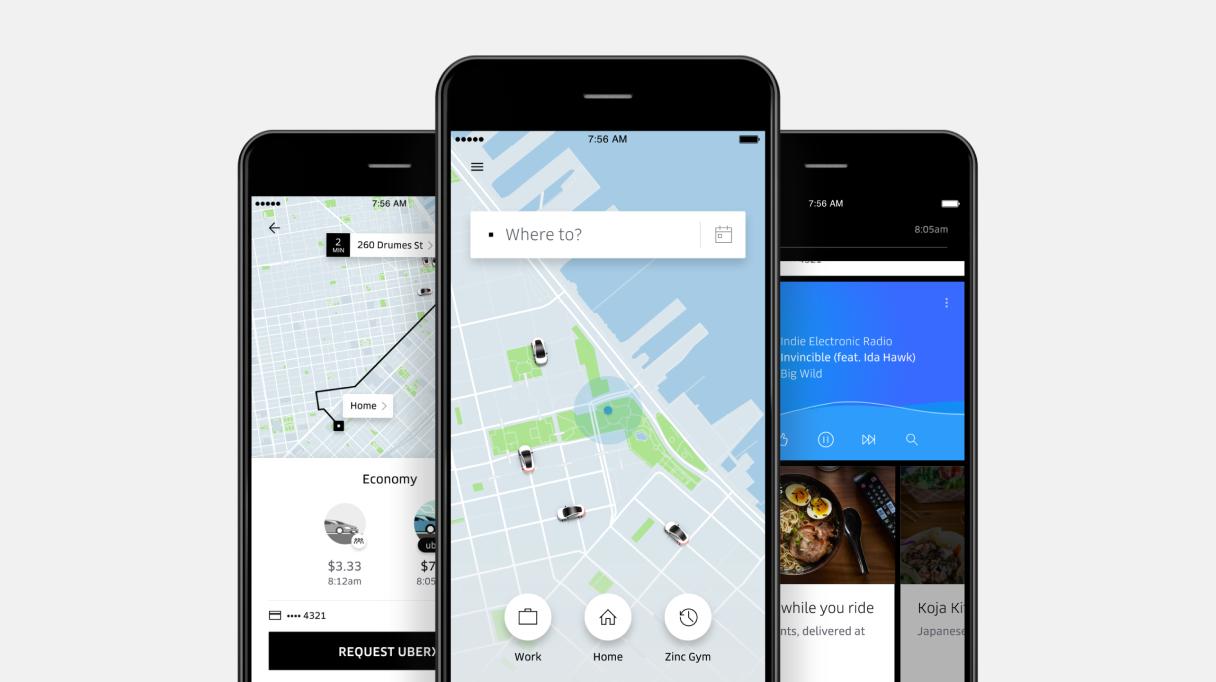What is call center automation?
Call center automation is the implementation of advanced technologies and software to handle routine, repetitive tasks within a call center, thereby reducing or eliminating the need for human intervention. This technology utilizes tools such as artificial intelligence (AI), machine learning and natural language processing (NLP) to manage tasks, allowing call center agents to focus on more complex and value-added activities.
Its significance in modern customer service operations cannot be overstated as it enhances operations by streamlining processes and improving efficiency.
By deploying automated customer service, call centers can reduce support costs and increase productivity by offloading recurring and mundane tasks from agents. Consequently, call center automation can help support teams improve their first contact resolution and average handling times.
Automation also reduces wait times and speeds up issue resolution, resulting in higher customer satisfaction. Additionally, it minimizes human error in repetitive tasks, ensuring consistent and accurate service delivery. By automating high-volume, low-complexity tasks, businesses can reduce operational costs while maintaining high service standards.
For example, a chatbot trained to answer the most frequently asked questions can serve as the first stage of support for simple queries and issues. Businesses can also augment their interactive voice response (IVR) systems with automatic speech recognition (ASR) to enable users to naturally converse with the system and get their questions answered.
How does call center automation work?
Call center automation uses software integrations, machine learning, and artificial intelligence to replace the work traditionally done by human agents. By leveraging data from various sources like operations, finances, and customer feedback, automation software can design workflows to reduce administrative hassle. This can range from simple tasks like sending post-call surveys to complex ones like analyzing emotive language in social media messages and suggesting actions.
Take for example: -
When a customer named John calls his telecom provider about a billing issue, an IVR system answers and uses NLP to understand his query. John selects the “billing inquiries” option and the system routes his call to the billing department. John enters his account number and RPA retrieves his billing information. An AI-powered chatbot explains a common issue, such as a late payment fee and offers solutions. If John wants to dispute the fee, the system transfers the call to a human agent with all relevant information.
The agent resolves the dispute and the system logs the resolution and updates John’s account. After the call, John is prompted to rate his experience, and the call center automation system collects his feedback through a customer survey. This automated process not only gathers valuable insights but also analyzes the feedback to improve future interactions.
7 Benefits of automation in call centers
Implementing automation in call centers offers numerous advantages that can significantly enhance operational efficiency and customer satisfaction. Here are seven key benefits:
Cost reduction: Automation handles repetitive tasks like data entry and skill-based routing, reducing the need for additional staff and lowering labor costs.
Improved customer satisfaction: Automated systems like chatbots and IVR provide 24/7 support, reducing wait times and enhancing the customer experience.
Increased efficiency: Automation optimizes resource allocation, allowing human agents to focus on complex tasks, boosting productivity and job satisfaction.
Enhanced accuracy: Automated systems minimize human error, ensuring consistent and accurate service delivery.
Scalability: Call automation allows call centers to scale operations easily during peak times without increasing staffing costs.
Better data management: Automated systems collect and analyze data efficiently, providing insights to optimize processes and improve service delivery.
Consistent service quality: Automation ensures standardized responses, providing consistent service quality regardless of when customers contact the call center.
Learn More: 7 Call Center Technology Solutions for 2024
Key components of call center automation
Call center automation involves several essential components that work together to streamline operations and enhance performance. Here are the key components and their roles:
Interactive voice response (IVR): Uses voice recognition to interact with customers, guiding them through menus and directing their calls to the appropriate department or agent.
Chatbots: AI-powered tools that handle simple customer interactions, providing instant support for frequently asked questions and common issues.
Automated call routing: Intelligently routes calls based on customer needs and agent availability, ensuring each call is handled by the most suitable agent.
💡 Did you know CCaaS providers such as Sprinklr use skill-based routing, a smart system that pairs cases with agents who have the right expertise to resolve them on the first try.
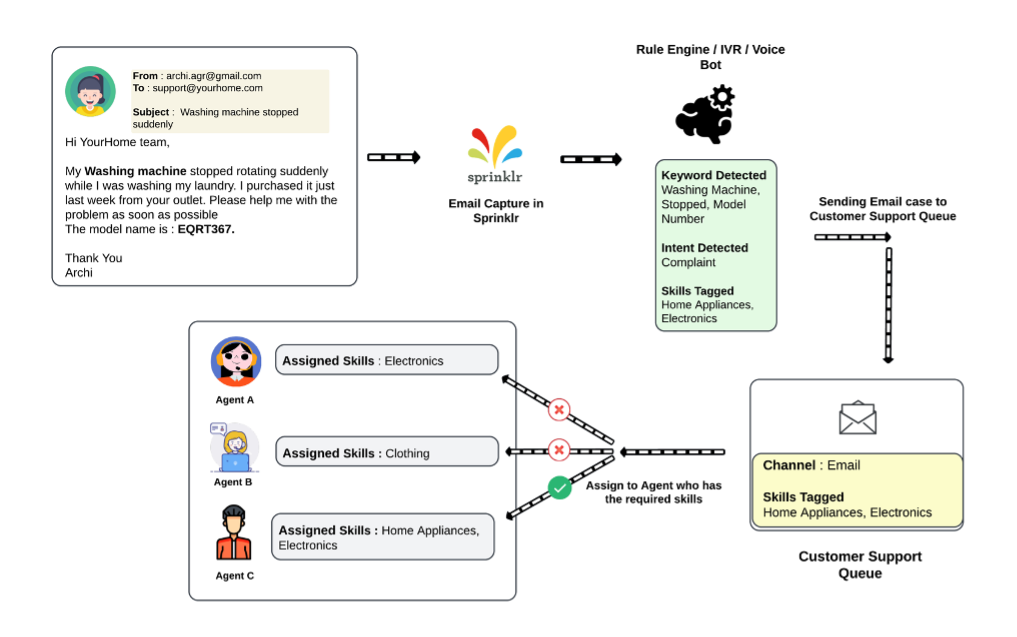
Imagine a customer support center for a tech company that offers products in multiple languages and has various technical support needs. When a customer calls in with an issue, the system identifies the skills required to resolve the issue and routes the call to the most suitable agent.
Scenario:
Customer Issue: A Spanish-speaking customer is having trouble with their billing.
Required Skills: Spanish language proficiency and knowledge of the billing system.
Routing Process:
Identify Skills: The system recognizes that the issue requires an agent who speaks Spanish and understands the billing system.
Match Skills: The system searches for available agents who have both of these skills.
Route Call: The call is routed to the first available agent who meets these criteria, ensuring the customer receives help from someone who can effectively communicate and resolve their issue.
This method ensures that customers are connected with agents who are best equipped to handle their specific needs, improving efficiency and customer satisfaction.
This method ensures each case receives proper attention,
The result?
Lower average handling and wait times, higher first-call resolution rates, and enhanced customer satisfaction. Example:
Robotic process automation (RPA): Automates repetitive tasks such as data entry, call logging and information retrieval, reducing the workload on human agents and minimizing errors.
Natural language processing (NLP): Enables systems to understand and interpret human language, analyzing customer interactions to determine intent and sentiment.
Machine learning: Improves the accuracy and efficiency of automated systems over time by analyzing past interactions and learning to predict customer needs.
Outbound call centers also rely on key components like workforce automation and conversational intelligence to streamline operations and enhance communication. These tools ensure efficient management and high-quality customer interactions.
Workforce automation: This component automates workforce management tasks such as scheduling, shift planning, and performance tracking. Optimizing agent availability and productivity reduces manual effort and minimizes errors, leading to smoother operations.
Conversational intelligence: This tool analyzes and interprets customer interactions to provide insights into customer sentiment, intent, and behavior. By leveraging these insights, call centers can enhance their outbound call strategies, resulting in more personalized and effective communication, improved call outcomes, and higher conversion rates.
These components work together to create a seamless and efficient call center operation, enhancing both customer satisfaction and operational efficiency.
💡Pro-tip: Leverage Generative AI for Enhanced Call Center Automation
Generative AI can revolutionize call center operations by automating complex tasks. It can create new content and responses based on context, making interactions more dynamic and personalized. This technology enhances automation by providing accurate and contextually relevant responses, reducing the need for human intervention.
By implementing generative AI, call centers can improve efficiency and customer satisfaction, allowing agents to focus on more complex and high-value tasks, ultimately boosting overall business performance.
8 ways to automate call centers [+Best Practices]
Automating call centers can significantly enhance efficiency, reduce costs and improve customer satisfaction. Here are eight practical tips and best practices for implementing and integrating automation tools:
1. Reduce call volumes using IVR
IVR systems use voice recognition to interact with customers, guiding them through menus and directing their calls to the appropriate department or agent. Ensure your IVR system is user-friendly and regularly updated to handle common queries effectively.

💡Pro-tip: Enhance Customer Experience with Conversational IVR
Implementing a conversational IVR system can significantly improve customer interactions by using natural language processing to understand and respond to customer queries more intuitively. Unlike traditional IVR systems that rely on rigid menu options, conversational IVR allows customers to speak naturally, making the experience more user-friendly and efficient.
Want to reduce costs by deflecting up to 70% of customer calls with AI-powered conversational IVR?
2. Enable customer self-service via virtual agents
Chatbots handle simple customer interactions, providing instant support for frequently asked questions (FAQs) and common issues. Train chatbots with a comprehensive database of FAQs and integrate them across multiple channels for consistent support.
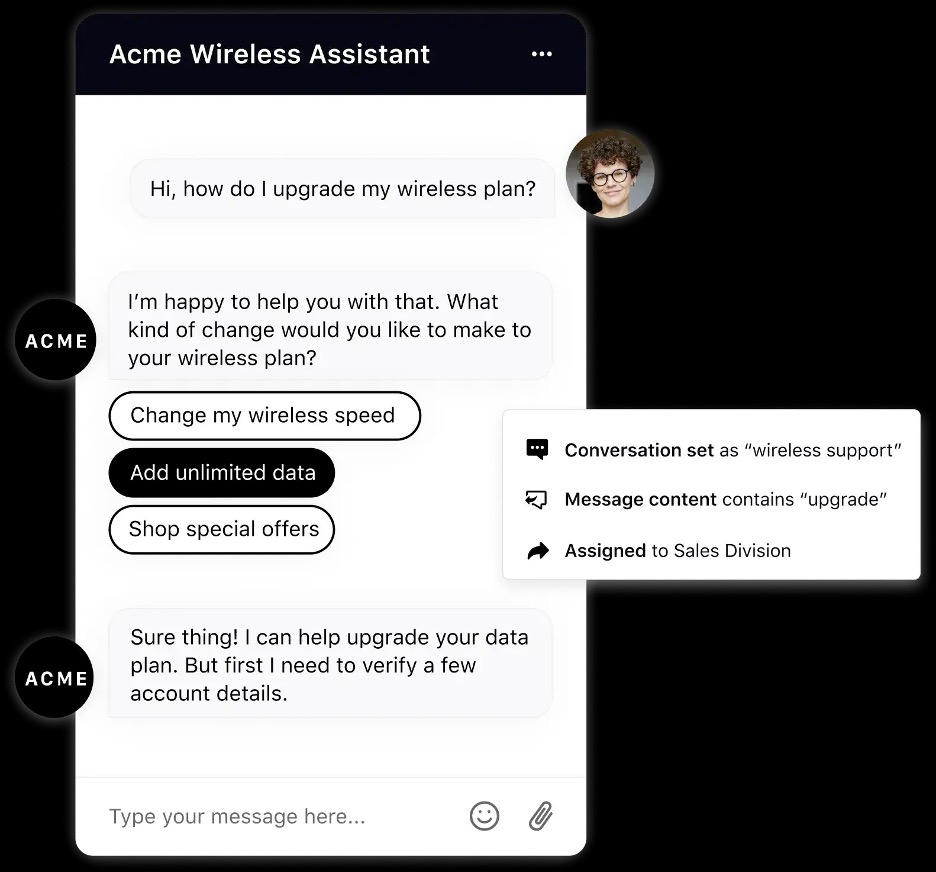
💡 Pro-tip: Elevate Customer Support with Voice bots
Integrate voice bots alongside chatbots to handle simple customer interactions more effectively. Voice bots can provide instant support for FAQs and common issues through natural, conversational interactions.
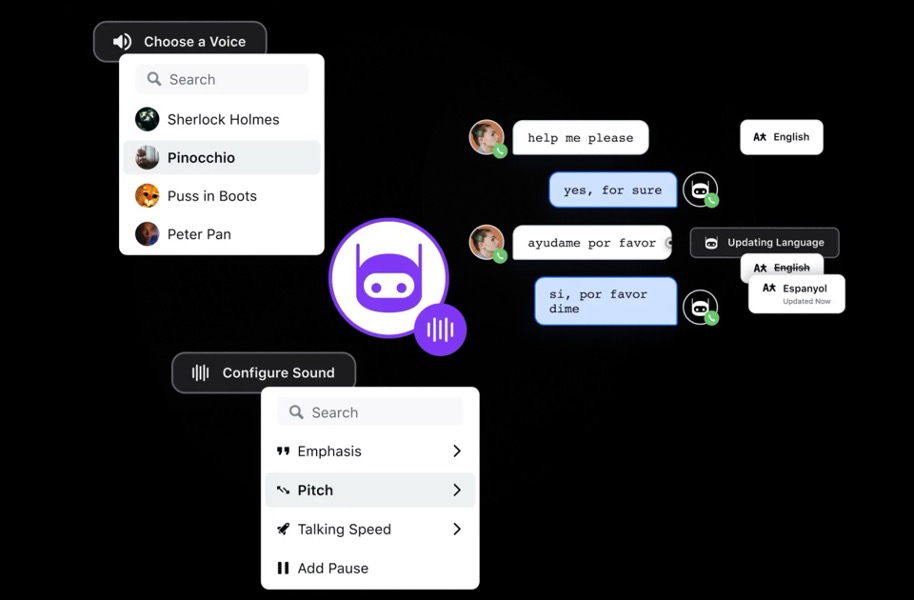
Train your voicebots with a comprehensive database of FAQs and ensure they are integrated across multiple channels for consistent and seamless support. This approach not only enhances the customer experience by offering a more personalized touch but also frees up human agents to focus on more complex queries.
3. Reduce waiting times via call routing
Automated call routing directs calls based on customer needs and agent availability, ensuring each call is handled by the most suitable agent. Use AI to analyze call data and optimize routing rules to leverage first call resolution best practices.
Here are key call routing logics to optimize this process:
Skill-based routing: Connects customers to agents with the specific skills needed for their issue, improving first call resolution rates.
Priority routing: Prioritizes calls based on criteria like VIP status or urgency, ensuring prompt handling of high-priority calls.
Geographic routing: Routes calls based on the caller’s location, connecting them to the nearest or most relevant branch.
Time-based routing: Directs calls based on the time of day or week, managing peak times effectively.
Round-robin routing: Distributes calls evenly among agents to balance workloads and prevent burnout.
Data-driven routing: Uses AI to analyze call data and optimize routing rules, enhancing efficiency and resolution rates.
IVR routing: Allows customers to navigate a menu to select the option that best matches their needs, directing calls appropriately.
Queue callback: Offers customers the option to receive a callback instead of waiting on hold, reducing perceived wait times.
📑Productivity Hack: Optimize Call Handling with Diverse Routing Logic
To maximize efficiency and customer satisfaction in your call center, leverage a variety of call routing logics. Implement skill-based routing to connect customers with the most knowledgeable agents, priority routing to ensure urgent or VIP calls are handled promptly, and geographic routing to direct calls based on location. Use time-based routing to manage peak times effectively, round-robin routing to balance agent workloads and data-driven routing to continuously optimize based on call data insights.
Additionally, IVR routing can help customers navigate to the right department, and queue callback options can reduce perceived wait times. By combining these strategies, you can create a seamless and efficient call-handling process.
4. Automate data entry and information retrieval using RPA
Robotic Process Automation (RPA) revolutionizes call center operations by automating repetitive tasks such as data entry, call logging, and information retrieval. This technology significantly reduces the workload on human agents, allowing them to focus on more complex and value-added tasks. By automating high-volume, low-complexity tasks, call centers can enhance efficiency and improve service quality. RPA bots can instantly access and compile customer information from various sources, reducing the need for customers to repeat themselves and speeding up resolution times.
💡Pro-tip: Streamline customer information access with RPA
One of the key advantages of RPA in call centers is its ability to ensure compliance and accuracy. RPA bots can meticulously follow regulatory requirements during data entry processes, reducing the risk of human error.
Additionally, they create detailed audit trails of all actions taken, which are invaluable for both internal reviews and external audits. This not only helps in maintaining compliance but also enhances the accuracy and reliability of customer data, leading to better decision-making and improved service quality.
5. Interpret human language using AI and natural language processing (NLP)
Natural Language Processing (NLP) empowers systems to comprehend and interpret human language, delving into customer interactions to discern intent and sentiment. This advanced technology facilitates more personalized and efficient responses, significantly enhancing the overall customer experience. By precisely identifying customer intent, NLP ensures that queries are directed to the appropriate department or agent, thereby reducing wait times and improving resolution rates.
Furthermore, sentiment analysis provides deeper insights into customer emotions, enabling more empathetic and effective responses. Continuously updating NLP models with fresh data maintains the system’s accuracy and relevance, allowing it to adapt seamlessly to evolving customer language and behavior.
Pro-Tip: Enhance Call Efficiency with Sprinklr AI+
Sprinklr AI+ offers several additional benefits beyond call notes and summarization. It enhances quality management by automating the quality scoring and sentiment analysis of conversations at a scale.
This ensures consistent and objective evaluation of customer interactions, leading to improved service quality. Sprinklr AI+ also augments existing conversational AI bots and chat platforms with generative AI capabilities for writing, translation, and summarization, making customer support more efficient and responsive.
By leveraging these advanced features, you can significantly boost productivity, improve the quality of insights and interactions and drive automation across various customer-facing functions.
Want to transform your call automation with AI?
Empower your customer service teams with cutting-edge AI technologies from Sprinklr AI, Google Cloud’s Vertex AI and OpenAI’s GPT models on one platform.
6. Enhance your campaign success with AI-powered outbound voice campaigns
Leverage AI-driven outbound voice campaigns to effectively target relevant audiences across multiple channels. By segmenting your audience based on data insights, you can ensure your message reaches the right people at the right time. Utilize auto dialers to streamline the calling process, increasing agent productivity and improving conversion rates. This approach not only enhances call connect rates but also boosts overall campaign outcomes, making your marketing efforts more efficient and impactful.
💡 Pro tip: Modern CCaaS solutions, such as Sprinklr Service leverage Generative AI to enhance agent efficiency through automated call summarization and after-call tasks. These advanced systems automatically extract key points from lengthy case histories, saving your agents valuable time.

Curious about how GenAI works?
7. Monitor and analyze call center performance for continuous improvement
Utilizing real-time analytics can significantly boost the performance of your automated call center. By setting up dashboards to monitor call center key performance indicators (KPIs), you can gain valuable consumer insights into various aspects of your operations. These insights help identify areas needing improvement, optimize processes, and ultimately enhance customer service. Tracking metrics such as call duration, resolution rates, and customer satisfaction scores allows for a more responsive and efficient call center.
8. Deploy a CCaaS platform
To fully harness the power of automation in call centers, integrating a comprehensive solution like Contact Center as a Service (CCaaS) is essential. CCaaS platforms offer a cloud-based approach to managing customer interactions, providing scalability, flexibility and seamless integration with other systems like CRM and ERP solutions.
This transition not only enhances operational efficiency but also significantly improves customer experience as you get three major benefits: -
Enhanced automation: CCaaS platforms leverage advanced technologies like AI and machine learning to automate routine tasks such as call routing, customer inquiries, and data entry. This reduces human error, speeds up response times, and allows agents to focus on more complex issues.
Improved service quality: By integrating omnichannel communication, CCaaS ensures that customer interactions are seamless across various platforms (phone, email, chat, social media). This unified approach enhances the customer experience by providing consistent and efficient service.
Real-time analytics and insights: CCaaS solutions offer robust analytics tools that provide real-time insights into customer interactions and agent performance. These insights help in identifying areas for improvement, optimizing workflows, and ensuring high service standards.
Let’s delve into the process of migrating to a CCaaS solution, exploring the benefits, challenges and steps involved in this transformative journey.
Migrate to a CCaaS solution to automate call center operations
Migrating to a Contact Center as a Service (CCaaS) solution can significantly enhance call center operations by leveraging cloud-based technologies. Here’s a five-step process for efficient migration: -
🤔Step 1: Assessment and planning
Evaluate current call center operations and identify areas for improvement. Define goals and objectives for migration. Choose a CCaaS provider that meets your requirements. (More on this later as we have shared a pro-tip in the near end)
📀Step 2: Data migration
Plan and execute the transfer of data from legacy systems to the new CCaaS platform. Ensure data integrity and security during the migration process.
🔁Step 3: Integration
Integrate the CCaaS solution with existing CRM, ERP and other business tools. Test integrations to ensure seamless operation.
🤾Step 4: Training and onboarding
Train staff on the new system and its features. Provide ongoing support and resources to help employees adapt.
🔎Step 5: Deployment and monitoring
Deploy the CCaaS solution in phases to minimize disruption. Monitor performance and gather feedback to make necessary adjustments.
📟 Possible Challenges During Ccaas Migration and How to Resolve them
Discover how to overcome common challenges in CCaaS migration with practical solutions for data transfer, integration, training, and security compliance.
1. Managing the challenges and disruptions of transferring data to the new system
Resolution: Conduct thorough data audits, use reliable migration tools and perform multiple test migrations to ensure data integrity.
2. The complexities of integrating CCaaS with existing CRM and other tools
Resolution: Utilize APIs and middleware for smooth integration and work closely with vendors to ensure compatibility and support.
3. Training staff to effectively use the new system
Resolution: Develop comprehensive training programs, offer hands-on workshops and provide ongoing support and resources.
4. Ensuring data security and compliance with regulations amidst the transition
Resolution: Implement robust security protocols, conduct regular security audits and stay updated with regulatory changes to ensure compliance.
Choosing the right CCaaS solution can be tricky, with potential pitfalls like hidden costs, integration issues, and security gaps. But don’t worry! Sprinklr has thoroughly evaluated the top 10 CCaaS vendors using G2 reviews, customer ratings, and our extensive industry expertise. We’ve summarized our findings in a concise listicle that includes:
Top features
Industry verdict
Real customer reviews
Trial and pricing info
Check out our list and find the perfect fit for your needs today.
A Case Study: How Deutsche Telekom successfully migrated to CCaaS, overcoming integration complexities
Transitioning to a cloud-based contact center can be daunting, especially when faced with integration complexities. Deutsche Telekom (DT) experienced significant challenges during its migration, including data migration issues and the need to seamlessly integrate its new CCaaS solution with existing CRM and business tools. These hurdles caused considerable pain, risking operational disruptions and potential customer dissatisfaction.
However, DT’s strategic approach turned these challenges into opportunities. By conducting thorough data audits, utilizing reliable migration tools and performing multiple test migrations, they ensured data integrity. They also leveraged APIs and middleware for smooth integration, working closely with vendors to ensure compatibility and support.
Introducing Sprinklr Service: The solution that made a difference
Sprinklr Service provided DT with the robust tools and support needed to overcome their integration challenges. With comprehensive training programs, hands-on workshops and ongoing support, DT’s staff quickly adapted to the new system, enhancing their efficiency and customer service capabilities.
This case underscores the importance of not just technology, but also the human element in driving organizational change. The dedication and effort of DT’s team, combined with the right technology, led to a successful transformation that significantly boosted customer satisfaction and operational efficiency.
Read the full case study here.
Are you curious and eager to replicate Deutsche Telekom’s success?
Discover how Sprinklr Service can help you manage your call center better and achieve outstanding results. Request a demo to see our advanced AI-driven solutions in action.
FAQ
Thank you for contacting us.
A Sprinklr representative will be in touch with you shortly.
Contact us today, and we'll create a customized proposal that addresses your unique business needs.
Request a Demo
Welcome Back,
No need to fill out any forms — you're all set.
